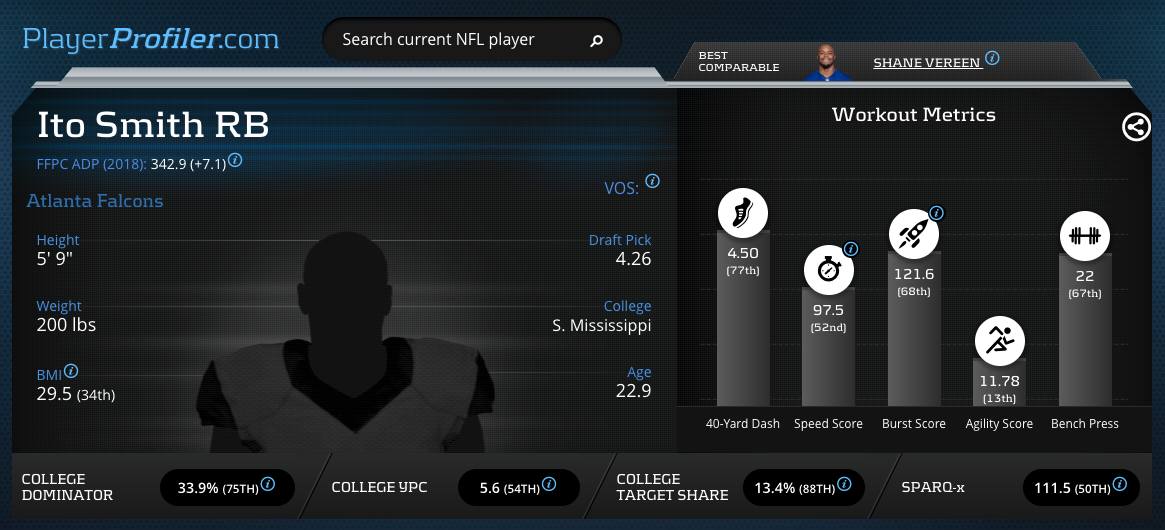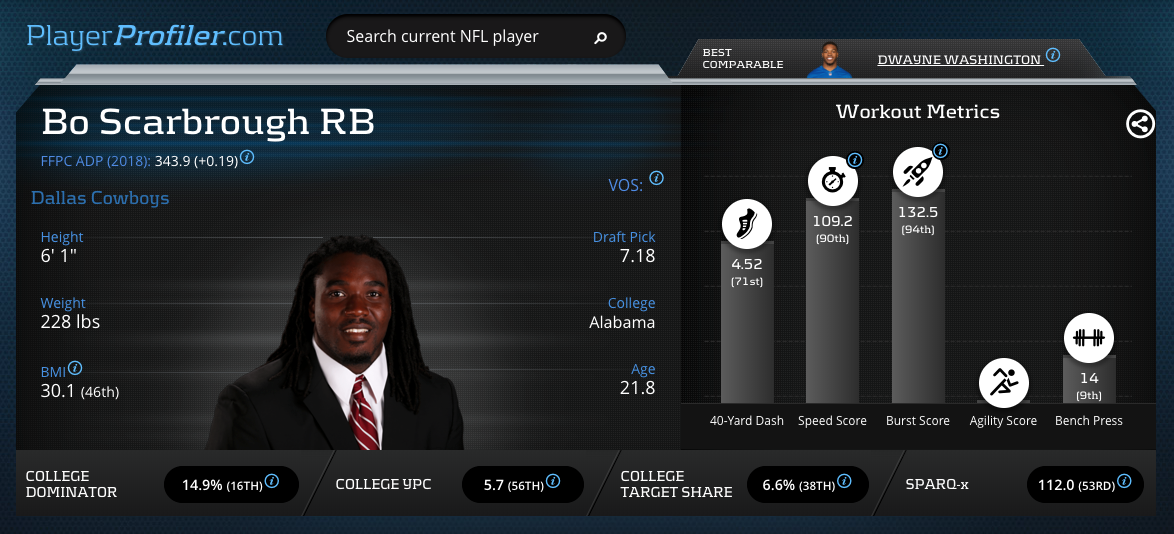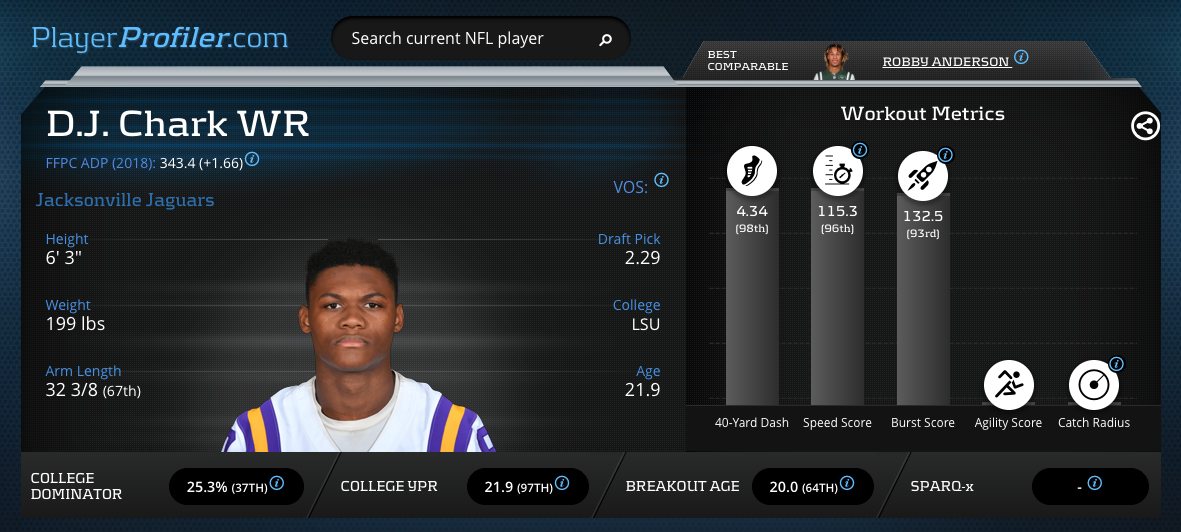The RotoUnderworld Team conducted its final superflex rookie mock draft of the season. We will be splitting up each of the four rounds into four separate pieces outlining the advanced stats, metrics, and analytics profiles justifying each selection. Without further ado, here are the results of our writer’s rookie mock draft with PPR superflex league parameters.
3.01 – Kalen Ballage, RB
Analyst: Marc Mathyk (@Masterjune70)
Rationale: With few running backs with huge ceilings left, one has to take a chance on Ballage. He’s 6-2, 228-pounds, and is built like a Todd Gurley/David Johnson hybrid. He joins the Dolphins similarly as Alvin Kamara joined the Saints last year. He has to compete with over-the-hill Frank Gore, and he will initially play second fiddle to Kenyan Drake. Look for him to surpass Drake, as he is a more complete back. He can run and catch, and he can dominate. He might have been unproductive in college, but so was Kamara, and look how he turned out. I think Ballage will hit his stride in the NFL and prove all doubters wrong.
Other considerations: None
Bean Counter’s two cents: Kalen Ballage offers a lot to like and a lot to hate. He is big, but is he too big at 6-2 and 228-pounds? That size sounds more like a bully X-receiver than a running back. When you watch him play and look at his production, he is more of a satellite back than a bruising big back. If he can figure out how to run between the tackles, he could be an absolute steal. However based on his meager 31st-percentile College Dominator and fifth-percentile yards per carry, it is more likely he is an awkwardly shaped, one-dimensional satellite back.
3.02 – Dante Pettis, WR
Analyst: Mark Leipold (@LeipoldNFL)
Rationale: No players left on the board had as much early potential as Pettis, who enter the 49ers’ roster with a thin depth chart at WR, newly acquired franchise quarterback (we think), and a creative offensive play-caller (probably). Pettis is a polished route-runner, but I was not very high on him pre-draft. This pick speaks much more to landing spot and early opportunity than to talent profile, production, and athleticism. Pettis is also excellent and willing on special teams, so it wouldn’t be surprising for him to see early playing time. Since I’m not a fan of him particularly, I’m hoping he’ll turn into a flip candidate if he churns out some fantasy points early on.
Other Considerations: John Kelly and Mark Walton both look like nice satellite backs, but their opportunity is questionable at best. Antonio Callaway has immense upside, and I like him in the third. But, his red flags put him just below Pettis for me.
Bean Counter’s two cents: This seemed like an NFL pick that was an obvious reach, but nobody really seemed to talk about it ’cause “Shanahan”. With a barely adequate production profile and no athletic testing, he is a complete wild card. I have to agree with Mark – he is an obvious flip candidate.
3.03 – Dallas Goedert, TE
Analyst: Miguel Chapeton (@DynastyGuruFF)
Rationale: I didn’t really like anything in this range and would rather have traded out in real life. Instead, I take the rookie tight end who could be part of the next great TE duo a la Gronk/Hernandez.
Other considerations: None
https://www.youtube.com/watch?v=m8qSxkjGcUE
Bean Counter’s two cents: If Dallas Goedert had gone to any other team, his draft stock would be a lot higher than it is. Goedert had an impressive College Dominator in the 89th-percentile, but he is going to be nearly 24 when his rookie season begins. With TE being one of the longest to develop positions and playing behind Zach Ertz, it’s unlikely Goedert will really do anything fantasy relevant until roughly his age 27 season. Throw in the fact that his breakout age is 21.7 (30th-percentile) and his lack of early playing time – he isn’t someone I want taking up space on my roster. If I have to take him because the value is too good, I am seeking the Ertz owner in my league and trying to extract a future second round pick or a buy-low WR from him.
3.04 – Ito Smith, RB
Analyst: Eric McClung (@ericmcclung)
Rationale: This one is pretty simple. Tevin Coleman is a free agent at the end of the season and Smith is a really good option for secondary running back in Atlanta in 2019. A lot of things can happen between now and then, but it’s the third round of a rookie draft. You need to tell yourself a story to buy any player still left on the board. Smith’s workout metrics were disappointing, but being snubbed from the NFL Scouting Combine was still a big whiff by the gatekeepers behind scouting industrial complex. Thankfully, Atlanta looked beyond that error and took Ito in the fourth round.
Other considerations: None

Ito Smith Advanced Stats & Metrics Profile
Bean Counter’s two cents: Ito Smith is undersized, yet somewhat bulky at 5-9 and 200-pounds. He has a 34th-percentile BMI. He had good college production and tested average athletically. If he was a little bigger, I would be a lot more excited about him. Nevertheless, I think he is a worthwhile pick at this point in the draft. He isn’t a building block type of player though, so if the opportunity to move him for someone with more prototypical size or exciting athleticism comes around, I would jump at the chance.
3.05 – Mason Rudolph, QB
Analyst: Corey Alexander (@calexander323)
Rationale: How long does Big Ben really have left? Or, how long will Pittsburgh give him? Rudolph is poised to step into a high powered offense at some point, maybe sooner than later. I will take any risk associated with that in a Superflex league every single time.
Other consideration: None
Bean Counter’s two cents: Mason Rudolph is a perplexing study. Analytically there is a lot to like. He has prototypical size at 6-5 and 233-pounds, he was very efficient in college (I know, conference, I get it), and he pushed the ball down the field as evidenced by his 98th-percentile Yards Per Attempt. Unfortunately, the NFL didn’t see what the analytics alluded to and passed on him until the third round. It is pretty rare for a QB to be successful if they aren’t drafted high, so this will be interesting to watch. In the third round of a superflex draft, I am happy to hold and wait to see what happens when Ben Roethlisberger retires. If I was making a trade with a team that had him, I would be adamant he is thrown into the deal. It shouldn’t cost much, and it looks like he could be a rare developmental quarterback who has a chance to work out.
3.06 – Justin Watson, WR
Analyst: Matthew Dwyer (@theDynastyMD)
Rationale: This is probably high for Justin Watson, but when you own Chris Godwin everywhere, you also need Justin Watson. The guy is super athletic, with a 123.3 (91st-percentile) SPARQ-x score and a 98th-percentile College Dominator rating. He is used to owning the field and being the guy. Every time in the third round. Yes, please.
Other considerations: None
https://www.youtube.com/watch?v=n158ZWBhL5A
Bean Counter’s two cents: Justin Watson is an analytics dream. He has great size, elite athleticism, and outstanding college production. He checks every box. The Tampa Bay Buccaneers must have someone on staff who frequents playerprofiler.com, because this is the second year in a row they invested a mid-round pick in a solid analytics prospect. Last year it was Chris Godwin; this year it is Justin Watson. Their wide receiver corps is going to be scary in a year or two. However, that is the main question mark for me. The Bucs have invested a lot in high quality players, and I would be concerned Watson may not get a true chance to break out until he gets to his second team. Like Mason Rudolph above, if I am making a trade with someone that owns him, I am trying to get him thrown into the deal to stash him on my taxi squad.
3.07 – John Kelly, RB
Analyst: Jerry Amole (@hangovercouch)
Rationale: I don’t think any RB has had it tougher over the past two months than John Kelly. A poor showing in the combine followed by a terrible landing spot on the LA Rams has rendered Kelly almost undraftable. He still has some redeeming qualities though – he was very productive at Tennessee and scored a 14.7-percent Target Share, proving he can play. However, he is merely a high upside stash at this point.
Other considerations: Chase Edmonds
Bean Counter’s two cents: John Kelly had one of the most disappointing landing spots among this year’s draft class. Having Todd Gurley at the top of your depth chart really tempers expectations. There was a lot to like about John Kelly; then, the athletic testing happened, and his stock took a hit as he graded as one of the least athletic backs to enter the NFL with an eighth-percentile SPARQ-x score. He fell in the draft all the way to the sixth round where the Rams scooped him up. Needless to say, there isn’t much hope for year one production. If Kelly is going to be a thing it will have to be on his next team, as I do not see him eating into Gurley’s workload.
3.08 – Bo Scarbrough, RB
Analyst: Matt Kelley (@Fantasy_Mansion)
Rationale: There are few, if any, immediate impact players available at the No. 32 overall selection, so chasing upside here made good sense. Sporting a 109.2 (90th-percentile) Speed Score and a 132.5 (94th-percentile) Burst Score, Bo Scarbrough will deliver the most on the available running lanes in Dallas. Ask the question: Which rookie’s value would rise the most if an established starting skill position player get injured? The answer is Scarbrough, an explosive running back operating in a quality running game. He is the ideal late-round upside pick in dynasty rookie drafts.
Other considerations: None

Bo Scarbrough Advanced Stats & Metrics Profile
Bean Counter’s two cents: Bo Scarbrough is big and fast with incredible burst. Unfortunately, he did next to nothing in college, as he put up a 14.9-percent (16th-percentile) College Dominator – which is underwhelming, to say the least. He also fell to the seventh round of the draft before the Cowboys picked him up, a pretty good indication the little amount he did put on film did not impress. That said, a running back with his attributes could make a pretty solid fill in for Ezekiel Elliott were he to miss games. If I don’t own Elliott, I don’t have much interest in rostering him.
3.09 – Mark Andrews, TE
Analyst: Craig Wambold (@CraigWambold)
Rationale: I didn’t want to take another tight end, but I had to stop Andrews’ slide. I know he was only the second tight end drafted by the Ravens, but he is four years younger than Hayden Hurst and won’t have the pressure to produce right away. He has the requisite height and weight to be the long term solution in Baltimore.
Other Considerations: D.J. Chark, J’Mon Moore
Bean Counter’s two cents: I was mildly intrigued by Mark Andrews heading into the draft because he put up average or better production across the board and he is fast, though overall not athletic. Then the draft hit, and he was taken by the Baltimore Ravens, which on its own wouldn’t be so bad, as they had a need at tight end. The strange thing is, the Ravens took Hurst in the first round, which was a massive reach, meaning they intend to use him early and often. That leaves Andrews fighting for scraps. Best case scenario is Andrews gets to play the Cameron Brate role in Tampa Bay, and the Ravens ask Hurst to stay in and block, much like O.J. Howard.
3.10 – D.J. Chark, WR
Analyst: Daniel Tarditi (@diti51)
Rationale: This selection was all about potential. D.J. Chark was extremely limited in his college production due to horrendous quarterback play by Danny Etling. Chark is the only wide receiver on the Jags’ current roster with the athletic profile and body control to be a potential WR1. I view him as Antonio Callaway without the off field red flags and dirty drug screen at the combine. I considered Hayden Hurst who should see immediate volume in Baltimore. I went for higher ceiling with Chark after Baltimore drafted Mark Andrews who could cap Hurst’s ceiling.
Other Considerations: Hayden Hurst

D.J. Chark Advanced Stats & Metrics Profile
Bean Counter’s two cents: D.J. Chark is blazing fast, with a 98th-percentile 40-yard dash and solid draft capital (second round pick). Unfortunately, he wasn’t overly productive, with a 37th-percentile College Dominator and is a little light at 6-3 and 199-pounds. If he was 10- to 15-pounds heavier, I would feel better about his chances.
3.11 – Chase Edmonds, RB
Analyst: Eric Lindberg (@eriiclindberg)
Rationale: Chase Edmonds is a player I followed closely during the pre-draft process and have grown very fond of. Edmonds has the requisite size and athleticism needed to be an every down workhorse should David Johnson go down. Even with Johnson playing at full strength, Edmonds will surely be involved in the passing game to an extent. Edmonds may not make an immediate impact with Arizona, but he immediately becomes a must-own player with tantalizing upside if given the opportunity to start at any point.
Other considerations: Justin Jackson, Jaylen Samuels
https://www.youtube.com/watch?v=bWqeynYJrBc
Bean Counter’s two cents: The Arizona Cardinals have already come 0ut and said Chase Edmonds is their one-for-one replacement for David Johnson were he to miss games. That is high praise for a rookie, especially one drafted in the fourth round. It is a double-edged sword though; David Johnson isn’t likely to cede much work when healthy, so Edmonds will not have much opportunity to produce in year one. David Johnson is a free agent this offseason though, which could open up an opportunity for Edmonds to battle for a starting role as early as next year. I will be trying to acquire Edmonds mid-season once everyone starts focusing on the points they need now rather than in the future.
3.12 – J’Mon Moore, WR
Analyst: Kyle Dvorchak (@ffkylethekid)
Rationale: I have to get the Packers’ third receiver eventually, right? In all seriousness, I’ll take the first receiver drafted by the Packers in the third round of a rookie draft every time. At 6-3 and boasting a 93rd-percentile SPARQ-x score, Moore has potential to win the third receiver role opposite of Davante Adams in 2018. If he does, his value will skyrocket immediately.
Other considerations: None
Bean Counter’s two cents: J’Mon Moore is 6-3 and 207-pounds. He has a 97th-percentile catch radius, and he plays on an Aaron Rodgers-led offense with an opening for a third wide receiver to emerge after Davante Adams and Randall Cobb. Luckily, this is the last player of the third round so you can stop reading this and start sending offers for J’Mon right now.


